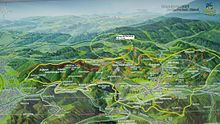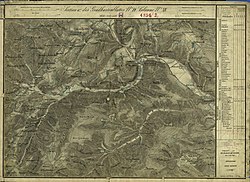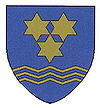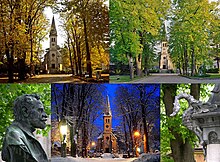Weissenbach an der Triesting
|
market community Weissenbach an der Triesting
|
||
|---|---|---|
| coat of arms | Austria map | |
|
|
||
| Basic data | ||
| Country: | Austria | |
| State : | Lower Austria | |
| Political District : | to bathe | |
| License plate : | BN | |
| Surface: | 15.87 km² | |
| Coordinates : | 47 ° 59 ' N , 16 ° 2' E | |
| Height : | 362 m above sea level A. | |
| Residents : | 1,703 (January 1, 2020) | |
| Population density : | 107 inhabitants per km² | |
| Postcodes : | 2564, 2565, 2571 | |
| Area code : | 02674 | |
| Community code : | 3 06 45 | |
| NUTS region | AT122 | |
| UN / LOCODE | AT WEE | |
| Address of the municipal administration: |
Kirchenplatz 1 2564 Weissenbach |
|
| Website: | ||
| politics | ||
| Mayor : | Johann Miedl ( ÖVP ) | |
|
Municipal Council : ( 2020 ) (19 members) |
||
| Location of Weissenbach an der Triesting in the Baden district | ||
 town hall |
||
| Source: Municipal data from Statistics Austria | ||
Weissenbach an der Triesting is a market town with 1703 inhabitants (as of January 1, 2020) on the Triesting River in the southern Vienna Woods in Lower Austria .
Geography and community structure

Community structure
The municipality includes the following five localities (population in brackets as of January 1, 2020):
- Gadenweith (53)
- Kienberg (15)
- Neuhaus (658)
- Schwarzensee (59)
- Weissenbach an der Triesting (918)
The community consists of the cadastral communities Gadenweith , Neuhaus , Schwarzensee and Weißenbach an der Triesting.
One of the well-known mountains in Weissenbach is the Peilstein , where there is also a climbing school run by the Austrian Alpine Club .
Neighboring communities
| Altenmarkt | Alland | |

|
Bad Vöslau | |
| Furth | Pottenstein |
traffic
In addition to the Leobersdorfer Bahn (Niederösterreichische Südwestbahn) with the Weissenbach-Neuhaus train station, Hainfelder Straße B 18 runs through. The Mödlinger road B 11 has Weissbach its beginning and leads via Mödling to Schwechat . The Vienna outer ring motorway can also be reached quickly via the B 11 .
history
See also: History of the Vienna Woods
Historical data from Weissenbach himself:
Schwarzensee is first mentioned with the construction of the Aegidius Chapel in 1146. But Neuhaus was also mentioned as early as 1251 in connection with the Neuhaus (Niwenhaus) castle there.
Mills and forges were built along the Triesting in the Middle Ages. The first mill mentioned in a document was built by Conrad von Arberg in 1360.
In the first half of the 19th century there was a wave of industrial start-ups due to the abundant water power, which was reinforced by the construction of the Leobersdorfer Bahn (or Südwestbahn ) in the fin de siècle . So z. For example, Prym 1888 , which specializes in sewing accessories, established a rolling mill for knitting needles .
1870 began Adolph Freiherr von Pittel in Weissenbach with the production of novel cement and the production of "Betonwaaren" and artificial stone products. He is considered one of the pioneers in the Austrian cement and concrete industry. Together with his friend Viktor Brausewetter , he also founded the construction company Pittel + Brausewetter, which still exists today, in 1870 .
Freiherr von Pittel was a socially minded entrepreneur for whom the future of Weissenbach was a particular concern. The construction of the Leobersdorfer Bahn through the Triestingtal goes back to his commitment . He also recognized early on the potential of Weissenbach as a summer resort and invested generously in the expansion of the community. The first electric street lighting, spacious parks, restaurants and hotels as well as the construction of the neo-Gothic Herz-Jesu-Kirche go back to his initiative. Weissenbach owned an outdoor swimming pool made of rammed concrete (Badpark) before 1886 and was rightly praised in contemporary travel guides as the “Pearl of the Triestingtal”. The beauty of the landscape and the proximity to Vienna were appreciated. It was not until 1895 that Simon von Wimpffen followed Pittel's example and built even more magnificent hotel and summer villa complexes in today's Neuhaus district by 1913. At that time, Weissenbach was a popular meeting place for important artists of the time: the librettist and director of the Theater an der Wien, Camillo Walzel built his summer villa (Zellgasse) in Weissenbach. The painters Franz Lefler and Heinrich Lefler and the architect Joseph Urban , who later became successful in the USA, were welcome summer guests in Weissenbach. Franz Lefler designed the frescoes in neo-Romanesque style on the so-called "Triestingheim", at that time a glamorous hotel. (Today it houses the elementary and special school.) Together, the artists designed summer festivals and staged open-air theater and - revolutionary for the time - children's theater performances in Weissenbach. One of Vienna's busiest architects at the time, Ludwig Schöne , was able to be won over from 1888 to design the aforementioned church, which was consecrated in 1893. The same architect is responsible for the beautiful arcade cemetery built in 1895 above the village. The Austrian author, Jeannie Ebner , who spent her youth in Weissenbach, set a literary monument in her novels to this cultural heyday of Weissenbach . A similar literary reference to the former grandeur of Neuhaus as the “Pearl of the Vienna Woods” can be found in Thomas Bernhard's Heldenplatz , which says: “Neuhaus is much nicer than Baden” and: “As children we had theater in the Salettl in Neuhaus Acted, real theater. "
Theodor Eduard Suess , the inventor of the Linz-Donawitz process , was born in Weissenbach in 1894 . He was the son of Franz Eduard Suess , who, like his even more famous father Eduard Suess , spent the summer in Weissenbach.
The machine and plant manufacturer Starlinger - who also played a key role in the development of Neuhaus - specializes in textile machines , rubber injection molding systems and recycling technology , operates two plants with around 350 employees in Weissenbach and is an important employer in the otherwise agricultural and forestry Vienna Woods.
Population development

| census | Residents |
|---|---|
| 2011 | 1,739 |
| 2001 | 1,650 |
| 1991 | 1,904 |
| 1981 | 1,446 |
| 1971 | 1,664 |
Source: Population development of Weissenbach an der Triesting. (PDF) Statistics Austria
Attractions
- Triestingtaler Heimat- und Regionalmuseum
literature
- Festschrift for the market survey of the community Weissenbach an der Triesting . Weissenbach community, Weissenbach 1981.
- Alfons Brammertz (Hrsg.): Home book of the market community Weissenbach ad Triesting. From then until today . Weissenbach community, Weissenbach 1986.
Web links
- Website of the market town of Weissenbach an der Triesting
- Website of the parish Weissenbach an der Triesting
- Website commemorating the victims of National Socialism from the market town of Weissenbach an der Triesting
- 30645 - Weissenbach an der Triesting. Community data, Statistics Austria .
Individual evidence
- ↑ Statistics Austria: Population on January 1st, 2020 by locality (area status on January 1st, 2020) , ( CSV )
- ↑ Ludwig Schöne. In: Architects Lexicon Vienna 1770–1945. Published by the Architekturzentrum Wien . Vienna 2007.
- ↑ Triestingtaler Heimat- und Regionalmuseum. Retrieved August 14, 2018 .







